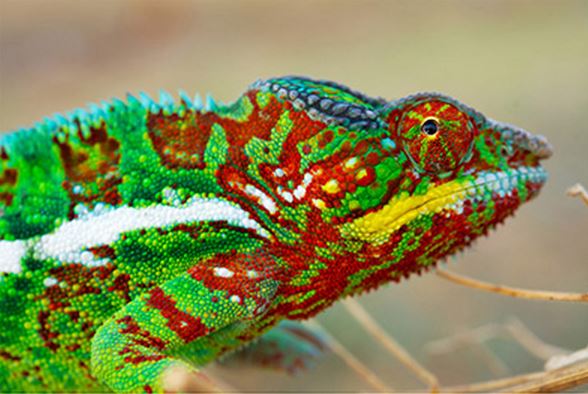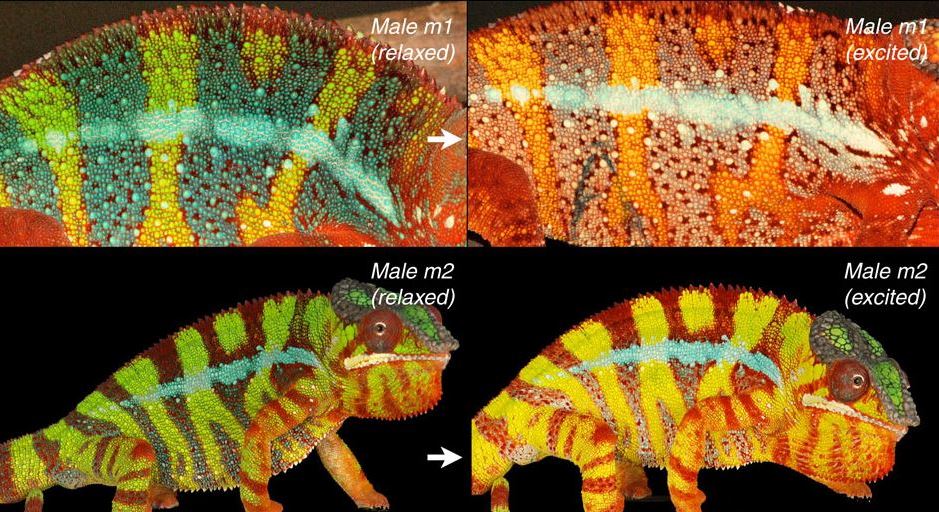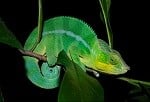Chameleons rearrange crystals inside specialised skin cells to accomplish their complex and rapid colour changes during social interactions and camouflage strategies, scientists at the University of Geneva in Switzerland discovered.
According to Professors Dirk van der Marel and Michel Milinkovitch, the vivid colour changes are the result of the active tuning of a lattice of nanocrystals present in the chameleon’s iridophores. An iridophore is a type of pigment cell present in the skin
The researchers, from the Faculty of Science at the University of Geneva (UNIGE), published their findings in the academic journal Nature Communications (citation below).

A male panther chameleon (Furcifer pardalis) in camouflage mode photographed in Madagascar. See its colours in social interaction mode in the picture below. (Image Credit: Michel Milinkovitch)
The team explained that in the skin of the chameleon, there is a deeper population of iridophores with bigger and less ordered crystals that reflect infrared light.
Having iridophores organised into two superimposed layers is an evolutionary first, the authors wrote. It allows the chameleon to shift rapidly from an efficient camouflage colour arrangement to spectacular displays used in social interaction, while providing passive thermal protection.
Male chameleons are popular because they can change their colours according to their behaviour. Scientists have long known what mechanisms are involved in making skin darker, but have been unable to explain what drives rapid spectacular color changes.
The panther chameleon, for example, can change its colourful arrangement completely within one or two minutes to court a female or face a male rival.
Blue, a structural color of the chameleon
Besides yellow, red and brown pigments, chameleons and other reptiles display structural colours.
Prof. Milinkovitch said:
“These colors are generated without pigments, via a physical phenomenon of optical interference. They result from interactions between certain wavelengths and nanoscopic structures, such as tiny crystals present in the skin of the reptiles.”

Panther chameleon in social interaction mode. (Image Credit: Michel Milinkovitch)
The nanocrystals are arranged in layers that alternate with cytoplasm (material within a cell excluding the nucleus) within iridophores. The resulting structure allows a selective reflection of specific wavelengths, which contributes to the vivid colours of chameleons and other reptiles.
Scientists from two laboratories at UNIGE worked together – combining their expertise in evolutionary biology and quantum physics – to determine what drives the transition of one flashy colour to another in the panther chameleon.
Co-first authors, physicist Jérémie Teyssier and biologist Suzanne Saenko, said:
“We discovered that the animal changes its colors via the active tuning of a lattice of nanocrystals. When the chameleon is calm, the latter are organised into a dense network and reflect the blue wavelengths.”
“In contrast, when excited, it loosens its lattice of nanocrystals, which allows the reflection of other colors, such as yellows or reds.”
What occurs with the chameleon is a unique example of an auto-organized intracellular optical system, the authors explained.

Two males (m1 and m2) while relaxed and excited. (Image: Nature Communications)
Nanocrystals as a heat shield
Within the chameleon’s skin there is a second deeper layer of iridophores, the researchers found.
Prof. Milinkovitch said:
“These cells, which contain larger and less ordered crystals, reflect a substantial proportion of the infrared wavelengths. This forms an excellent protection against the thermal effects of high exposure to sun radiations in low-latitude regions.”
Scientists had never before come across iridophores in two superimposed layers. It allows the chameleons to change their colourings rapidly, while at the same time gaining thermal protection.
The researchers plan to explore the mechanisms involved in the development of an ordered nanocrystals lattice within iridophores. They also want to determine what the molecular and cellular mechanisms are that allow chameleons to control the geometry of this lattice.
Citation: “Photonic crystals cause active colour change in chameleons,” Jérémie Teyssier, Suzanne V. Saenko, Dirk van der Marel & Michel C. Nature Communications 6, Article number: 6368. DOI: 10.1038/ncomms7368Milinkovitch.
Video – Chameleon vivid colour change
This (silent) video shows how a chameleon’s colours change. You can also see the colour change of a single cell.

